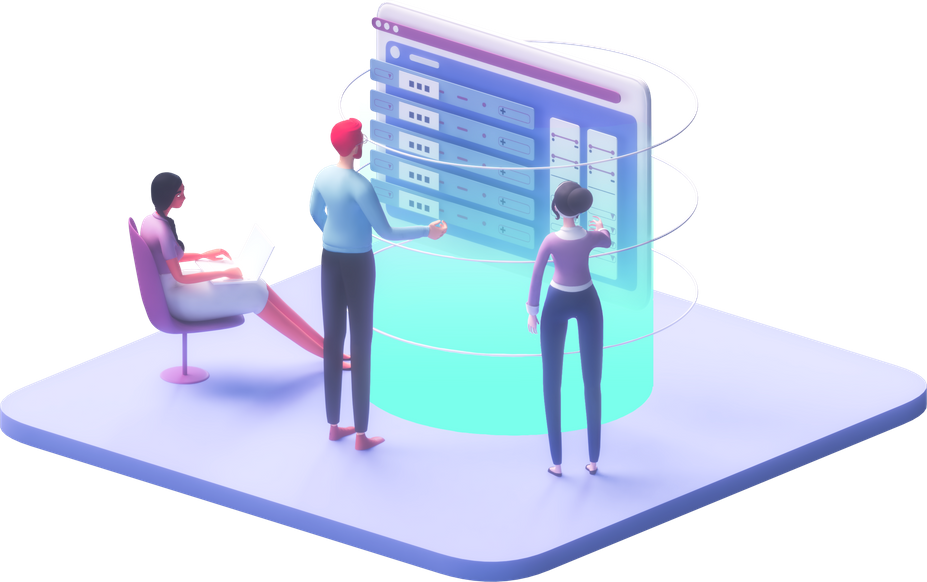








Trusted Mobile Application Development Company
Mobile Application development is one of the most sensitive areas in automation and therefore requires your special attention. Especially mobile usability is a complex topic that requires lots of refining, intense user research, and even more testing with real users. It is important that your app easy to use; otherwise, it might end up with low ratings, which cause damage to the app’s and possibly your company’s reputation. Syntrino offers you just that, and more.


Trusted by 100+ happy clients including these Fortune companies
Custom Mobile App Development Offerings
Benefits of working with Syntrino
New business opportunities at your doorstep
Ensuring you identify and unlock opportunities is our job. We develop applications that harness the power of enterprise solutions and deliver the best in class user experience.
Increasing your consumer retention and ROI
Syntrino ensures that your ideas nourish and turn into products with high output and retention rates. We use a host of combinations with research, design thinking and testing to bring high-potential use cases.
Consultations and strategy
We take great interest in understanding your business needs, streamline processes that need an upgrade, redefine the user experience and develop a comprehensive roadmap that not only aligns with your goals.
Best security practices
We adopt best practice to reduce security risks, tests potential vulnerabilities and encrypts/sanitizes data before use. develop a comprehensive roadmap harness the power of enterprise You can be confident that your are in safe hands.
How Do We Deliver Custom Software Using Agile?




Mobile App Strategy
Mobile apps we built are secure set to define your business roadmap.
User Experience Design
Our prototype engineers crease a manipulating user behaviour design.
Mobile Bugs Handling
Our mobile quality analyst engineers ensure tested product over numerous bugs testing modules
Support & Maintenance
Our mobile app development company offers 24*7 support & maintenance after launch
Industries we serve
We provide a range of services across industries, including the following:
Our services span indoor stadium management platforms for storage, location, and retrieval of information, ticketing systems, crowd control systems, and facility management systems, etc.



We offer mobile CRM, an operational, analytical and collaborative software that ensures the bank managers can manage their clients effortlessly



We offer an integrated mobile system for managing hospitals, including services such as medical, administrative, financial, legal and other corresponding services.



A mobile app for restaurants and hotels to speed up their checkout process, accept credit cards payments, track sales, inventory and manage other business function.



An API-driven instant messaging & video conference that ensures higher connectivity with real time data communication built over server-less technology.



Mobile app for supply chain management for multiple locations, safety stocks, reorder points, cycle counts, demand & distribution requirement planning



E-learning mobile app with user-centred design standard for content delivery and assessment process with high security, accessibility, and data maintenance.



Frequently Asked Question (FAQ)
-
What is the difference between Mobile vs. Desktop Web Application Testing?
The main difference between a mobile and desktop client is that, in the mobile case, the Web content is interpreted by a Web browser that runs on a client computer. This type of browser has many restrictions that a typical desktop client does not have, mainly since it runs on a mobile device and often uses a wireless network with low bandwidth. Overcoming these restrictions, requires creative designing and programming solutions. Some device limitations while testing mobile web applications are- ● Small screen size ● Restricted CPU power ● Limited RAM (Random Access Memory) ● Limited secondary storage ● Power management dependencies ● Limited battery life dependencies ● Cumbersome UI
-
What things I should keep in mind while using mobile web application development tools?
Due to the unique nature of mobile web application testing which depends greatly on the client hardware, it is useful to have emulators to help test the application prior to the actual deployment on the physical device. Two useful types of emulators are device emulators and browser emulators. Most vendors that license their operating systems or development platforms offer a device emulator. Since the devices are OS-based, given the same operating system, you might be able to emulate different types of devices by changing the skin. The term skin is used to describe the capability to change the outside (the ‘skin’) of a device, while leaving the inside (the operating system) the same, to give you a different device.
-
Are there any testing considerations I should be aware of?
Yes, although we offer these solutions, some considerations which may require further deliberation include: - How do the test devices manage their cache? Is it user-configurable? -How do you determine the expected results for the way content is displayed across platforms and browsers? - External links: How are they handled in offline browsing? - Memory-full testing or stress testing: How do you execute memory-full and near-full test cases on the test platforms? - How do you write reusable test cases for different devices? - If your Web site supports multiple formats, including WML, i-Mode and HTML, which rules does a browser use to determine which content to load? - Some sites recognize the browser version to determine compatibility. Are you checking for compatibility? -Does the browser properly interpret tables, frames, lists, checkboxes, drop-downs, scripts, and so on?
-
How Syntrino ensure quality mobile application product delivery?
While at Syntrino, we use the following basic mantra for long lasting success of your products: ● Less Is More: When testing the usability of an app, this is the design principle we follow. We check the app for useless navigation elements and buttons and talk to your team or the usability expert and get them removed. The same applies to text and words. Unlike others, we try to focus on the primary content of the app and keep the goal and the problem the app should solve in mind and get rid of anything that is distracting. ● Detailed and Explanatory: We check if the app is self-explanatory and ask ourselves these questions: - Is the user able to see the elements with which he or she can interact? - Is every element on the screen clear and understandable? ● Attention to Patterns: We believe that every app should follow a usability and design pattern. If such a pattern is in place, we verify that your app follows those rules. If there is no pattern available, we keep an eye on the look-and-feel of the append check that all of the elements are accessible.
-
What if I do not have a project spec or job description written out?
Whether your project is at the early ideation stage or you have all features drawn out, our tech consultation team works with you to prepare a detailed tech solution and execution plan. We are huge believers in high output management and everything we suggest from tech architecture to talent skill set will focus on getting results and speeding up the time to market.
-
How is Syntrino different from other online talent marketplaces, local agencies, and software consulting companies?
Freelance marketplaces like Upwork, Toptal, Gigster, Freelancer, etc can help you get in touch with thousands of developers. They provide transparent access to devs but you have to vet candidates and take care of everything. These platforms do not provide a guarantee of delivery and results. Tech agencies and software consultancies follow outdated engagement and execution models. The teams and devs hired through them don't integrate with your team well. Transparency and collaboration are lacking. We started Syntrino with the goal of bringing assurance, certainty, and transparency in the software development services space. Most of our competitors provide TRANSACTIONAL services. You post a gig, they match you up with a developer and you take it from there. We aren't a transactional service.
-
How do you design mobile apps?
Even the most visually amazing app can and will fail to perform well on the app store if it’s not intuitive and lacks usability. As a user, you would want to open an app and feel like you already intuitively know everything — where to click next, what actions to perform, how to jump to a particular place, etc.The second you get stuck, you give up and go try another app. Sounds familiar? So what do we do to make sure this doesn’t happen to the potential users you just spent so much time researching? We do UX. What is UX Design? UX is the process of creating products that provide meaningful and relevant experiences to users. This involves the design of the entire process of acquiring and integrating the product, including aspects of branding, design, usability, and function — The Interaction Design Foundation UX design is an ongoing process. With each update, you should consider the way people are using your app. If an update makes the accessibility of your app complex or increases the number of taps to the users’ destination, you’re heading off course and it’s time to correct. Let’s get into some of the UX design process. Step 1: Information Architecture Simply put, Information Architecture (or IA) is figuring out how all the content should be structured to maximize accessibility and ease of use. It is the user journey, the path that users will take to perform their intended action. It is in this stage that you decide which features will help users go through the journey, as well as overall functionality of your app. You also decide how to present and organize this information. Typically, the IA process begins by writing down the list of desired features and a some rough sketches of what needs to be displayed and where in the app. The outcomes of this step are user flows and user journeys which serve as building blocks for creating wireframes. Step 2: Wireframing your App A wireframe, also called a page schematic or screen blueprint (just kidding, no one actually calls them that), is a visual guide that shows the skeletal framework of an app. It gives you an idea on the infamous “look and feel”. With a wireframe in front of you, it’s easy to explain the concept to your dev team and set reasonable expectations from the start. Wireframing eases the often messy transition between the stages of the project. It is easier and cheaper to erase stuff from a sketch than it is to rewrite code. Good wireframes are essential in helping you to launch your app more effectively. Step 4: Clickable prototype with UI Now that you have some screens to play with, you’re going to want to familiarize yourself with InVision, an essential tool of the product designer’s toolbox. This isn’t an InVision guide, but InVision is so easy to use that it doesn’t need one. Just upload your screens to InVision and link them together.
-
How do you choose mobile app architecture?
These are the things to keep in mind when choosing mobile app architecture. Portability Portability is the ability of the system to react to the environmental changes. In case of Mobile applications, the change in environment may be frequent considering the technology and market demand changes. These changes may result in change in servers, database, etc. The good Mobile Application Architecture ensures the system to be portable enough to respond to these changes keeping the impact of change at minimal level. Maintainability Considering the requirement change due to change in environment i.e. market demand or the ease with which a component can be modified to correct faults, improve performance, or other attributes, always there is a need of maintenance for the Mobile Applications. A Good Mobile Application Architecture ensures the high maintainability of the mobile application. It reduces the efforts and complexity of the change implementation which is in favor of the developers. Manageability How efficiently and easily a software system can be monitored and maintained to keep the system performing, secure, and running smoothly. Reusability Reusability always leads to faster application development and structured development approach. Good Architecture always considers the reusability aspect during design of components and protocols. Testability The application needs to undergo testing process in order to ensure the consistency of the application under various conditions. This raises a need of regression testing for each component of the system. Good Mobile Application Architecture ensures that the each component is separately testable. Security Security of the data is one of the major non-functional requirement of the application. The application architecture should be robust enough to secure the data consumed by the application. The architecture of Mobile Application should be in sync with organization’s security ecosystem. Any data stored on the device (in-memory or persistent) should be encrypted to ensure security. The organization may opt for Mobile Device Management (MDM) tool to impose security constraints on the application. The application architecture should be able to accommodate any interface to such Mobile Device Management tools. Performance The performance of application plays an important role in mobile applications. Mobile users expects quick response from the application specifically compared to desktop/web applications. If the application is taking long time to retrieve or display the details, there is a high possibility that the users would not like the application and they might stop using the application. A mobile application architecture should ensure to meet the performance expectations of the users. While making architectural decisions, we need to keep these in mind as well. 1. Components of the app should be nicely organized and decoupled. 2. Architecture should speak about the business domain of the project. Is it a food delivery application Or maybe one for financial institutions? 3. Scalability: How easy it is to add more features? Having an elegant solution might save us a lot of time and money in the future. 4. How the architecture fits the requirements of the business domain. Is it a heavy data driven app? Does it have a lot of forms that require user input? What is the complexity of the app that we are going to build? Is it a “5 screens” app or “20 screens” app? 5. Will team be able to work independently on features, without blocking themselves? 6. What are the key components that we want to test? 7. What is the deadline and budget for the project? What is the trade-off that we must do in terms of quality — time of delivery? 8. Consider all network scenarios.
-
What are the Mobile Web Application Tests Syntrion Offer?
We adhere to offering following best practice: 1. Add-on Tests: Thick-client mobile devices such as PDAs and smartphones offer secondary storage and the capability to install add-on software including the browser itself, other client-side components as well as templates. You need to consider the implications of the installation of these elements and design test cases to cover various installation scenarios, including cross operating systems, cross devices, cross releases of browsers, and so on. Syntrino offers these solutions on-the-go. 2. Data Synchronization-Related Tests: Due to the fact that wireless bandwidth is often limited, we provide design solutions to download web content for offline browsing. Syntrino performs this synchronization process in two ways: A. The method for downloading data onto the mobile device that does not have a connection to the Internet or network is to synchronize with the desktop application. In this case, the desktop already has a connection to the Internet. In turn, web content on the desktop can be transferred over to the device via a data synchronization process. B. Synchronization can also be done wirelessly. We assist you in synchronizing your device with a proxy server via a wireless modem connection. Pre-formatted web pages stored on web servers connected to the proxy server can then be transferred to the device during the synchronization process. 3. UI Implementation and Limited Usability Tests: Some of the factors that affect the usability judgments include the target audience to which you market and the limitation of the devices, such as screen size, bandwidth, device-specific and website-specific technologies. Therefore, in testing for UI implementation and usability errors, we provide solutions to some dire problems that may arise, including some pressing questions such as: ● How do the data input methods on supported platforms affect usability? ● How does the Web site under test appear in the browser with default settings for attributes such as page size, images, text size, and so on? ● Does text-wrapping work properly? ● Is the navigation intuitive? ● Are the input interfaces consistent and friendly? ● Is there consistency among menu, button, and error-handling implementations? ● Are the graphics well fit and positioned in the display? 4. Browser-Specific Tests: Some of the mobile application testing issues that are worth reiterating here, and for which Syntrino offers services in developing test cases to seek out problems, include- - The side effects introduced by the application under test - Incompatibility or lack of support for one or more markup languages, such as HTML, WML, cHTML, xHTML, HTML, or XML. - Support for PQA or Web Clipping-based applications - Legacy support issues - Caching issues 5. Platform-Specific Tests: When your company develops an application for a particular platform, such as Windows, UNIX, MacOS, Palm Computing, or Windows PocketPC, you need to execute these tests to seek out bugs that are platform-specific rather than functionality-specific. Although the scope and depth of platform-specific testing will be dictated by the test requirements or objectives, we offer standardized platform-specific tests and several other vendor-driven standards for mobile applications. 6. Configuration and Compatibility Tests: Syntrino offers customized solutions across a range of products, including: ● Cross devices ● Cross operating systems including standards and OEMs ● Cross browsers ● Cross versions ● Mobile Testing Support Tools ● Graphic formats etc. 7. Connectivity Tests: Our connectivity tests involve seeking out errors related to how the device and the network can be connected to each other; and while being connected, how interference during data transmissions can cause functionality as well as data integrity, failures.
SYNTRINO Guarantee
We know that if the client’s project launches smoothly, they’ll
come back for more.We’re willing to over-invest in guaranteeing results,
rather than under-invest to make our financial reports look pretty in the short-run.
We offer a risk-free trial period of up to two weeks. You will
only have to pay if you are happy with the developer and wish to continue.
If you are unsatisfied, we’ll refund payment or fix issues on our dime.







